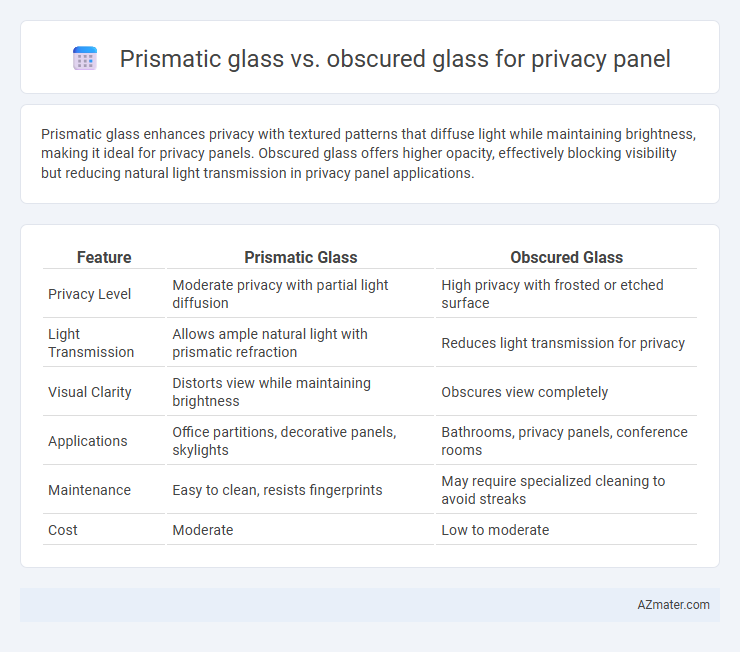Prismatic glass enhances privacy with textured patterns that diffuse light while maintaining brightness, making it ideal for privacy panels. Obscured glass offers higher opacity, effectively blocking visibility but reducing natural light transmission in privacy panel applications.
Table of Comparison
| Feature | Prismatic Glass | Obscured Glass |
|---|---|---|
| Privacy Level | Moderate privacy with partial light diffusion | High privacy with frosted or etched surface |
| Light Transmission | Allows ample natural light with prismatic refraction | Reduces light transmission for privacy |
| Visual Clarity | Distorts view while maintaining brightness | Obscures view completely |
| Applications | Office partitions, decorative panels, skylights | Bathrooms, privacy panels, conference rooms |
| Maintenance | Easy to clean, resists fingerprints | May require specialized cleaning to avoid streaks |
| Cost | Moderate | Low to moderate |
Introduction to Privacy Glass Solutions
Prismatic glass and obscured glass offer distinct privacy solutions for interior and exterior panels, with prismatic glass featuring angular patterns that diffuse light while maintaining brightness and obscured glass utilizing frosted or textured surfaces to block visibility effectively. Prismatic glass enhances natural light penetration and visual appeal, making it ideal for areas requiring moderate privacy without sacrificing daylight. Obscured glass prioritizes maximum privacy by significantly reducing transparency, suitable for bathrooms, offices, or any space demanding confidential environments.
What is Prismatic Glass?
Prismatic glass is a type of textured glass engineered with a series of prismatic patterns that distort light and visibility, enhancing privacy while allowing natural light to pass through. Unlike obscured glass, which often features a frosted or etched surface to blur images, prismatic glass uses precise geometric designs to refract light, reducing glare and creating visual interest. This makes prismatic glass an effective choice for privacy panels in offices, bathrooms, and meeting rooms where both discretion and light transmission are essential.
What is Obscured Glass?
Obscured glass is a type of privacy glass designed with a textured or frosted surface that diffuses light and blurs images, preventing clear visibility while allowing natural light to pass through. Commonly used in privacy panels for bathrooms, offices, or entryways, obscured glass enhances privacy without sacrificing illumination. Its varying patterns and finishes offer customizable levels of opacity to suit different privacy requirements.
Aesthetic Differences: Prismatic vs Obscured Glass
Prismatic glass features a textured, patterned surface that refracts light to create dynamic visual effects, enhancing the aesthetic appeal with depth and complexity. Obscured glass offers a more uniform, frosted appearance that diffuses light softly, providing a sleek and modern look focused on privacy. The choice between prismatic and obscured glass balances decorative intricacy against minimalist privacy, influencing the overall design ambiance of privacy panels.
Light Transmission and Diffusion Performance
Prismatic glass provides superior light transmission with a high level of clarity while diffusing light to reduce glare, making it ideal for privacy panels that require natural illumination without compromising visibility. Obscured glass offers lower light transmission but excels in diffusion performance by scattering light more uniformly, enhancing privacy through blurred imagery and maintaining ambient brightness. Selecting between prismatic and obscured glass depends on the balance needed between maximum light entry and effective visual privacy in architectural applications.
Privacy Effectiveness Comparison
Prismatic glass offers moderate privacy by diffusing light and obscuring direct visibility while allowing natural light transmission, making it suitable for spaces requiring privacy without complete opacity. Obscured glass provides a higher level of privacy due to its frosted or textured surface that significantly limits visibility from both sides, ideal for areas demanding maximum confidentiality. When comparing privacy effectiveness, obscured glass outperforms prismatic glass by delivering near-total visual obstruction, ensuring enhanced privacy in sensitive environments.
Durability and Maintenance Considerations
Prismatic glass offers high durability due to its thick, tempered construction, making it resistant to impact and suitable for high-traffic areas requiring privacy. Obscured glass, often lighter and less robust, may require more frequent maintenance to prevent scratches and clouding over time. Both types provide privacy, but prismatic glass tends to maintain its clarity and structural integrity longer, reducing long-term upkeep costs.
Energy Efficiency and Insulation
Prismatic glass enhances energy efficiency by diffusing natural light, reducing the need for artificial lighting while maintaining privacy, and its textured surface improves thermal insulation by minimizing heat transfer. Obscured glass offers high privacy but typically has lower energy efficiency since it diffuses light less effectively and may not provide the same level of insulation against temperature fluctuations. Choosing prismatic glass for privacy panels optimizes daylight utilization and thermal performance, making it a superior option for energy-conscious designs.
Cost Comparison: Prismatic vs Obscured Panels
Prismatic glass panels typically cost more than obscured glass due to their complex light-diffracting patterns that enhance privacy while allowing natural light transmission. Obscured glass tends to be more affordable, as it uses simpler manufacturing processes to achieve frosted or opaque finishes, providing adequate privacy at a lower price point. Choosing between prismatic and obscured panels depends on budget constraints and desired light diffusion effects for privacy solutions.
Choosing the Best Glass Type for Privacy Panels
Prismatic glass offers enhanced light diffusion and visual privacy by refracting light through its textured surface, making it ideal for areas requiring daylight without clear visibility. Obscured glass features a frosted or etched finish that blurs images, providing a higher level of privacy while allowing ample light transmission. Selecting between prismatic and obscured glass depends on the desired balance between natural light diffusion and the degree of opacity required for effective privacy panels.

Infographic: Prismatic glass vs Obscured glass for Privacy panel
 azmater.com
azmater.com